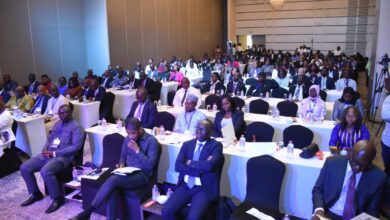Examining the concept of employees’ Group Life Insurance Revised Guidelines

The National Pension Commission (PenCom) and the National Insurance Commission (NAICOM) have recently jointly signed the revised Regulation on Retiree Life Annuity, Guidelines on Group Life Insurance for Employees and Contributory Pension Scheme (CPS) Retiree Pack. EDET UDOH examines the concept of the guideline.
The Guidelines was signed on behalf of PenCom by its Acting Director General, Mrs. Aisha Dahir-Umar, while NAICOM’s Commissioner for Insurance/Chief Executive Officer, Mr. Olorundare Sunday Thomas, appended for NAICOM.
Introduction
This Guideline is made pursuant to the provisions of the Pension Reform Act (PRA) 2014 relating to procurement and maintenance of Group Life Insurance Policy in favour of employees. It is also to establish uniform set of rules and standards in relation to the application of the legal framework stated hereunder:
Legal Frame work
Section 4(5) of the PRA 2014, provides that “every employer shall maintain a Group Life Insurance Policy in favour of each employee for a minimum of three times the annual total emolument of the employee and premium shall be paid not later than the date of commencement of the cover.”
Section 4(6) also provides that “where the employer failed, refused or omitted to make payment as and when due, the employer shall make arrangement to effect the payment of claims arising from the death of any staff in its employment during such period”. Section 8(1) of the PRA 2014 provides that “where an employee dies, his entitlements under the Life Insurance Policy maintained under this Act shall be paid by an underwriter to the named beneficiary in line with Section 57 of the Insurance Act.”
Section 9 of the PRA 2014 provides that “where an employee is missing and is not found within a period of one year from the date he was declared missing, and a board of Inquiry set up by the Commission makes a determination that having regards to available information and all relevant circumstances, it is reasonable to presume that the employee is dead, the provisions of Section 8 shall apply”. Section 57 (1) of the Insurance Act 2003 provides that “a policy of insurance shall not be made on the life of a person or other event without inserting in the policy the name of the person interested in it, or for those whose benefit or on whose account the policy is made.”
Section 57 (2) of the Insurance Act 2003 provides that “the provisions of subsection (1) of this section shall not invalidate a policy for the benefit of unnamed persons from time to time, falling within a specified class or description if the class or description is stated in the policy, with sufficient particularity to make it possible to establish the identity of all persons who at any given time are entitled to benefit under the policy.” Section 120 of the PRA 2014 defines “annual total emolument in relation to Group Life Insurance Policy to be maintained by an employer means the gross emoluments of an employee or deceased person.”
General requirements
Under this provision, the Guideline stated that the employer shall fully bear all costs in relation to procurement of Group Life Insurance Policy, and this shall be in addition to, and separate from, the contributions made by the employer to each employee’s Retirement Savings Account (RSA), as required by the PRA
The Group Life Insurance Policy, according to the Guideline, shall be effected through the purchase of a Life Insurance Policy issued by a Registered Insurance Company, licensed and authorized to conduct Life Insurance Business by the National Insurance Commission (NAICOM) under the Insurance Act 2003.
For ease of administration, the Guideline averred that a consortium of eligible insurance companies, as determined by this Guidelines, warning that a Life Insurance Company shall not be allowed to underwrite the Group Life Insurance Policy of its employees, that the Group Life Insurance benefits due to the beneficiary shall not be encumbered or subject to any deductions by both the employer and insurance company.
Eligibility of insurance companies
According to the Guideline, “An Insurance Company shall be licensed by NAICOM to carry on life insurance business in order to qualify to provide Group Life Insurance under the PRA 2014. NAICOM shall make public the list of licensed and registered insurance companies eligible to conduct life insurance business. NAICOM shall forward the list to PenCom annually. “Such eligible insurance companies shall continue to comply with the PRA 2014 as regards: a) Transfer of its legacy pension portfolio in line with Section 47 of the PRA 2014; b) Remittance of monthly contributions (i.e. employer and employee portions) into the RSAs; c) Procurement of life insurance policies for its employees; and d) Settlement of fully documented insurance claim arising from the PRA 2014.”
Group life insurance policy coverage
The Guideline under this subject, noted that the Group Life Insurance Policy shall provide cover to the insured against death, stating that the insurance coverage shall be for twelve (12) months, and shall be renewable at the end of each period.
The premium payable on the Group Life Insurance Policy, the Guideline added, shall be pro-rated as applicable where an employee joins the Contributory Pension Scheme (CPS) in the course of the year, stating further that where an employee leaves the service of the employer before the expiration of twelve months, the insurance company shall return or set aside to the credit of the employer the premium relating to the unexpired period.
“Annual Total Emolument, for the purpose of Group Life Insurance Policy under the PRA 2014, shall be the gross emolument of an employee. Gross Emolument is annual total remuneration for the employee before any deductions. Employee may notify PenCom of non-compliance. Notwithstanding the provisions of Section 4.6 above, employers that have existing Group Life Insurance policies for their employees, which have enhanced benefits when compared to the minimum may maintain such policies,” the Guideline added.
Required documentation
Here the Guideline requires the employer to provide at the minimum necessary information of its employees and beneficiaries as required in the Know Your Customer (KYC) guideline issued by NAICOM, noting that each employer shall obtain a Group Life Insurance certificate from the insurance company.
Such certificate shall be accompanied by a schedule which shall indicate, amongst other things, the period of coverage, renewal date, number and details of staff including their gross total emoluments, the benefit payable, the annual premium and date of payment, just as it posited that the insurance company shall issue the insurance certificate to employers within a month from the inception/renewal date of the life insurance policy.
It added, “The employer shall display a copy of the Group Life Insurance certificate in a conspicuous place within its premises, for the information of the employees, and as evidence of having taken such policy.
Operational terms
The Guideline stated that the sum insured for the purpose of Group Life Insurance shall be at the minimum 300% of the gross annual emolument, pointing out that the Group Life Insurance Policy document shall clearly define the procedure for filing and settlement of claims and that the premium rates payable on Group Life Insurance Policies shall be within the rate table stipulated by NAICOM.
Death of an employee
“Where an employee dies, the employer shall immediately notify the insurance company and commence processing death benefits claim on behalf of the deceased employee, as prescribed in the operational terms of the Group Life Insurance Policy and in all cases, not later than (365) days from the date of the incident giving rise to a claim. Where the employer fails to notify the insurance company of the employee’s death as stated above, the employer shall be liable to pay the death claim from its resources.
“Where an employer failed to carry out a Group Life Insurance on behalf of his employee and death occurred in active service, such employer shall be liable to pay the 300% of the gross emolument for the Group Life Insurance Policy to the beneficiaries of the deceased employee in line with the provisions of the PRA 2014. Where an employer fails to insure its employees up to 300% of their gross emoluments as defined above, the employer shall be liable to pay the difference to the beneficiary of the deceased employee.
“Notwithstanding the provisions above, any employer who fails to maintain a Group Life Insurance Policy for the benefits of its employees is in contravention of the PRA 2014. The employer shall provide at a minimum the necessary information of its employees and beneficiaries as required in the Know Your Customer (KYC) issued by NAICOM.
Missing employee
According to the Guideline, where an employee is missing, the employer shall report to the employee’s Pension Fund Administrator (PFA), noting that the PFA, after its due diligence and necessary confirmation, shall notify and request PenCom to set up a Board of Inquiry for the missing employee. It explained that the PFA shall submit all necessary documentary evidence required for constituting the Board of Inquiry for Missing employee as stipulated in the Regulation on the Administration of Retirement and Terminal Benefits issued by PenCom.
“The documentary evidence required above shall include the Police Report, letter of confirmation of disappearance from the employer, Employee’s passport photograph, newspaper publication of the missing employee and any other document as may be required from time to time. The Board of Inquiry shall within thirty (30) working days of receipt of complete evidence required for its deliberations communicate its findings to PenCom and ….PenCom shall communicate the decision of the Board of Inquiry to the employer, the Insurance Company, the PFA and NAICOM. Where the Board of Inquiry presumes the missing person dead, the provisions of Section 8 of the PRA 2014 shall apply.”
Settlement of claims
“Insurance company shall communicate acceptance or rejection of liability in respect of death claims to the employer not later than 90 days after the claim has been delivered, positing that the insurance company shall settle claims not later than 90 days after the issuance of discharge voucher, noting that any complaints relating to claims settlement shall be resolved with the insurance company and that where such complaint remains unresolved, the employer shall notify NAICOM,” it added.
Sanctions
He the Guidelines empowers PenCom to impose administrative sanction against any employer for noncompliance with any provisions of this Guideline, stating that where an insurance company violates any provisions of this Guideline, the insurance company shall be sanctioned appropriately by NAICOM.
Ensuring safety of Retiree Life Annuity funds, assets
Speaking with the Blueprint, Head, Corporate Communications Department, PenCom, Peter Aghahowa, noted that the revised Regulations and Guidelines provide clarity on the Provisions of the PRA 2014 in areas relating to Retiree Life Annuity with focus on guiding stakeholders to make informed decision, ensure safety of Retiree Life Annuity funds and assets, address concerns of mis-selling and de-marketing by pension and insurance operators as well as bringing stability and growth into the financial sector of the economy.
Performance of Retiree Life Annuity
On the performance of Retiree Life Annuity (RLA) portfolio, the National Insurance Commission (NAICOM) said it shows marginal growth recording 83,917 contracts purchased for a total premium of ₦376,585,316,488.84 as at end of Q2, 2020 which represents 2.69 per cent and 1.58 per cent growth in count and volume, respectively in Q2, 2020 from end of Q1, 2020, while the industry fund portfolio grew by 15.34 per cent from ₦401,513,860,403.49 in Q1, 2020 to ₦463,104,007,353.66 at the end of the quarter under review.
NAICOM noted that the growth year on year during the last three years for RLA business averaged 25.45 per cent in volume, while RLA fund portfolio growth has averaged 37.22 per cent notwithstanding the RLA payouts made (i.e. cumulative total payments of ₦167,209,437,755.05 as at end of Q2, 2020).
The analysis of the annuity payouts, premium receipts and portfolio fund balance shows a clear representation with the fund balance (i.e. ₦463,104,007,353.66) being higher than the cumulative premium amounts received (i.e. ₦376,585,316,488.84) notwithstanding the cumulative annuity payouts earlier stated, NAICOM posited.





